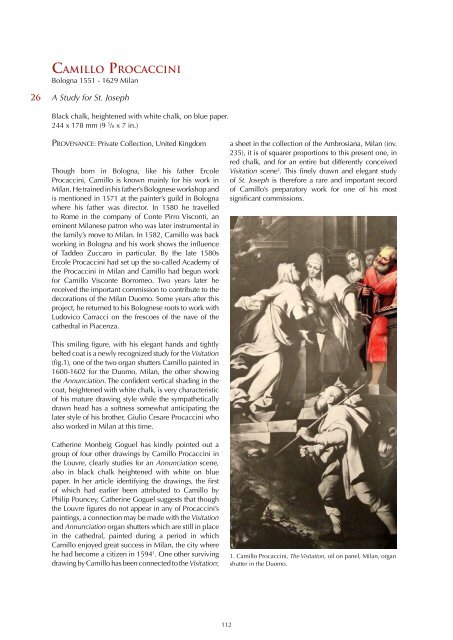You also want an ePaper? Increase the reach of your titles
YUMPU automatically turns print PDFs into web optimized ePapers that Google loves.
Camillo Procaccini<br />
Bologna 1551 - 1629 Milan<br />
26<br />
A Study for St. Joseph<br />
Black chalk, heightened with white chalk, on blue paper.<br />
244 x 178 mm (9 5 /8 x 7 in.)<br />
Provenance: Private Collection, United Kingdom<br />
Though born in Bologna, like his father Ercole<br />
Procaccini, Camillo is known mainly for his work in<br />
Milan. He trained in his father’s Bolognese workshop and<br />
is mentioned in 1571 at the painter’s guild in Bologna<br />
where his father was director. In 1580 he travelled<br />
to Rome in the company of Conte Pirro Visconti, an<br />
eminent Milanese patron who was later instrumental in<br />
the family’s move to Milan. In 1582, Camillo was back<br />
working in Bologna and his work shows the influence<br />
of Taddeo Zuccaro in particular. By the late 1580s<br />
Ercole Procaccini had set up the so-called Academy of<br />
the Procaccini in Milan and Camillo had begun work<br />
for Camillo Visconte Borromeo. Two years later he<br />
received the important commission to contribute to the<br />
decorations of the Milan Duomo. Some years after this<br />
project, he returned to his Bolognese roots to work with<br />
Ludovico Carracci on the frescoes of the nave of the<br />
cathedral in Piacenza.<br />
a sheet in the collection of the Ambrosiana, Milan (inv.<br />
235), it is of squarer proportions to this present one, in<br />
red chalk, and for an entire but differently conceived<br />
Visitation scene 2 . This finely drawn and elegant study<br />
of St. Joseph is therefore a rare and important record<br />
of Camillo’s preparatory work for one of his most<br />
significant commissions.<br />
This smiling figure, with his elegant hands and tightly<br />
belted coat is a newly recognized study for the Visitation<br />
(fig.1), one of the two organ shutters Camillo painted in<br />
1600-1602 for the Duomo, Milan, the other showing<br />
the Annunciation. The confident vertical shading in the<br />
coat, heightened with white chalk, is very characteristic<br />
of his mature drawing style while the sympathetically<br />
drawn head has a softness somewhat anticipating the<br />
later style of his brother, Giulio Cesare Procaccini who<br />
also worked in Milan at this time.<br />
Catherine Monbeig Goguel has kindly pointed out a<br />
group of four other drawings by Camillo Procaccini in<br />
the Louvre, clearly studies for an Annunciation scene,<br />
also in black chalk heightened with white on blue<br />
paper. In her article identifying the drawings, the first<br />
of which had earlier been attributed to Camillo by<br />
Philip Pouncey, Catherine Goguel suggests that though<br />
the Louvre figures do not appear in any of Procaccini’s<br />
paintings, a connection may be made with the Visitation<br />
and Annunciation organ shutters which are still in place<br />
in the cathedral, painted during a period in which<br />
Camillo enjoyed great success in Milan, the city where<br />
he had become a citizen in 1594 1 . One other surviving<br />
drawing by Camillo has been connected to the Visitation;<br />
1. Camillo Procaccini, The Visitation, oil on panel, Milan, organ<br />
shutter in the Duomo.<br />
112
















